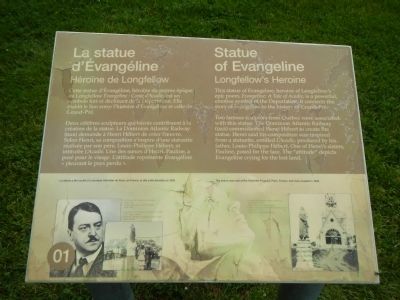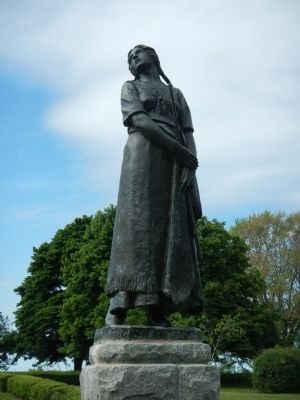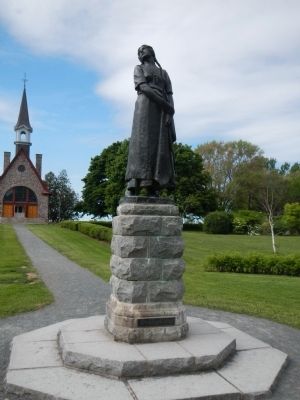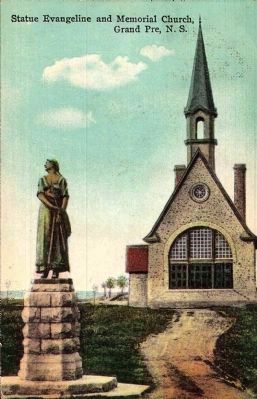Near Grand Pré in Kings County, Nova Scotia — The Atlantic Provinces (North America)
Statue of Evangeline
La statue d’Évangéline
— Longfellow’s Heroine / Héroïne de Longfellow —
This statue of Evangeline, heroine of Longfellow’s epic poem, Evangeline: A Tale of Acadie, is a powerful emotive symbol of the Deportation. It connects the story of Evangeline to the history of Grand Prê.
Two famous sculptors from Quebec were associated with this statue. The Dominion Atlantic Railway (DAR) commissioned Henri Hébert to create the statue. Henri said his composition was inspired from a statuette, entitled L’Acadie, produced by his father, Louis-Philippe Hébert. One of Henri’s sisters, Pauline, posed for the face. The “attitude” depicts Evangeline crying for the lost land.
French
Deux célèbres sculpteurs québécois contribuent à la création de la statue. La Dominion Atlantic Railway, (DAR) demande à Henri Hébert de créer l’oeuvre. Selon Henri, sa composition d’inspire d’une statuette réalisée par son père, Louis-Philippe Hébert, et intitulée L’Acadie. Une des soeurs d’Henri, Pauline, a posé pour le visage. L’attitude représente Évangéline «pleurant le pays perdu».
Topics and series. This historical marker is listed in these topic lists: Arts, Letters, Music • Women. In addition, it is included in the Acadian History series list.
Location. 45° 6.556′ N, 64° 18.719′ W. Marker is near Grand Pré, Nova Scotia, in Kings County. Marker can be reached from Grand-Pré Road close to Old Post Road, on the left when traveling north. Touch for map. Marker is at or near this postal address: 2205 Grand-Pré Road, Grand Pré NS B0P, Canada. Touch for directions.
Other nearby markers. At least 8 other markers are within 3 kilometers of this marker, measured as the crow flies. Memorial Church/L'église-souvenir (within shouting distance of this marker); The Expulsion of the Acadians (about 180 meters away, measured in a direct line); Grand-Pré Rural Historic District (about 210 meters away); Grand Pre Marsh Body (approx. 0.3 kilometers away); The Attack at Grand Pré/La bataille Grand Pré (approx. 0.6 kilometers away); The Landscape of Grand Pré/Le Paysage de Grand-Pré (approx. 0.7 kilometers away); Landscape of Grand Pré/ le Payage de Grand Pré (approx. 2.1 kilometers away); Site de l'école Acacia Villa/Site of Acacia Villa School (approx. 2.1 kilometers away). Touch for a list and map of all markers in Grand Pré.
More about this marker. This marker is on the grounds of Grand Pré Rural Historic Site.
Also see . . .
1. Evangeline: A Tale of Acadie - Henry Wadsworth Longfellow. Henry Wadsworth Longfellow's first epic poem, Evangeline: A Tale of Acadie, published in 1847, is a story of loss and devotion set against the deportation of the Acadian people in 1755. The poem elevated Longfellow to be the most famous writer in America and has had a lasting cultural impact, especially in Nova Scotia and Louisiana, where most of the poem is set. (Submitted on November 8, 2014, by Barry Swackhamer of Brentwood, California.)
2. Evangeline - Wikipedia. Prior to the influence of Longfellow's poem, historians generally focused on the British founding of Halifax (1749) as the beginning of Nova Scotia. Longfellow's poem shed light on the 150 years of Acadian settlement that preceded the establishment of Halifax.
The Expulsion was planned and executed by New Englanders and British. Longfellow omitted from the poem New England's
responsibility for the event. Through his poem, Longfellow defines the British as responsible for the expulsion and America is cast as a place of refuge. This omission may explain in part why Americans were able to celebrate a poem that was based on a traumatic historic event for which they were significantly responsible. (Submitted on November 8, 2014, by Barry Swackhamer of Brentwood, California.)
Credits. This page was last revised on April 15, 2018. It was originally submitted on November 8, 2014, by Barry Swackhamer of Brentwood, California. This page has been viewed 1,448 times since then and 82 times this year. Photos: 1, 2, 3, 4. submitted on November 8, 2014, by Barry Swackhamer of Brentwood, California. 5. submitted on November 8, 2014. • Andrew Ruppenstein was the editor who published this page.




